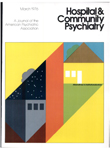Irrational Determinants of the Place of Psychiatric Treatment
Abstract
Observations of 392 women admitted to a psychiatric hospital indicated that 24 were well suited to treatment in a day center and that 208 could feasibly be treated there. However, only 59, or 28 per cent of those for whom day care was feasible, were able to take advantage of that alternative. The others were excluded by financial limitations, refusal to accept the day center option, administrative delays, and inaccurate classification of treatment setting. The authors believe that underuse of the day center was due as much to doctors' inexperience, personal biases, and unfamiliarity with the facilities as it was to psychopathology and financial realities. They found that many clinicians were not aware of the factors that affect their decisions about the use of a partial hospitalization setting.
Access content
To read the fulltext, please use one of the options below to sign in or purchase access.- Personal login
- Institutional Login
- Sign in via OpenAthens
- Register for access
-
Please login/register if you wish to pair your device and check access availability.
Not a subscriber?
PsychiatryOnline subscription options offer access to the DSM-5 library, books, journals, CME, and patient resources. This all-in-one virtual library provides psychiatrists and mental health professionals with key resources for diagnosis, treatment, research, and professional development.
Need more help? PsychiatryOnline Customer Service may be reached by emailing [email protected] or by calling 800-368-5777 (in the U.S.) or 703-907-7322 (outside the U.S.).



